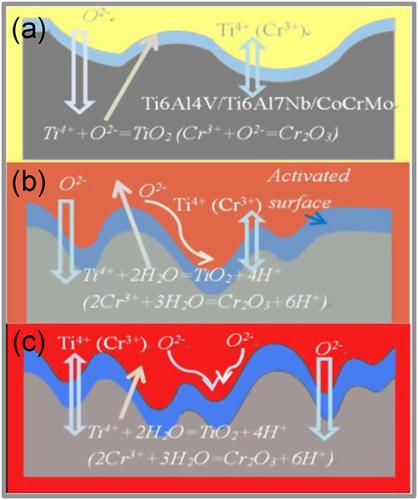当前位置:
X-MOL 学术
›
Mater. Corros.
›
论文详情
Our official English website, www.x-mol.net, welcomes your feedback! (Note: you will need to create a separate account there.)
Effect of synovial fluid temperature on the corrosion resistance of Ti6Al4V, Ti6Al7Nb, and CoCrMo alloys
Materials and Corrosion ( IF 1.8 ) Pub Date : 2020-02-26 , DOI: 10.1002/maco.202011530 Xingxing Fang 1 , Songquan Wang 1 , Dahan Li 1 , Yongbo Guo 1 , Ningning Hu 1
Materials and Corrosion ( IF 1.8 ) Pub Date : 2020-02-26 , DOI: 10.1002/maco.202011530 Xingxing Fang 1 , Songquan Wang 1 , Dahan Li 1 , Yongbo Guo 1 , Ningning Hu 1
Affiliation

|
The frictional heat generated during the operation of the joint prosthesis in vivo could change the corrosion resistance of the prosthesis material. In this paper, the corrosion behavior of three medical alloys at different synovial fluid temperatures was analyzed using electrochemical measurement technology. Furthermore, the scanning electron microscope and energy‐dispersive spectrometer were used to characterize the surface morphology and composition of the alloys after long‐term immersion. The results show that increasing temperature causes the open‐circuit potential of titanium alloy to shift negatively and the corrosion tendency to increase. The increasing temperature leads to the decrease of activation energy of titanium alloy, which in turn results in the increase of corrosion current density and accelerated corrosion. The results of Nyquist curves confirmed that the radius of the capacitive arc decreased with the increase of temperature, indicating the deterioration of corrosion resistance. The CoCrMo alloy shows the same regularity as the titanium alloy in 0.9% NaCl, though no obvious regularity in 25% newborn bovine serum; this may be related to the complexity of the corrosion system.
中文翻译:

滑液温度对Ti6Al4V,Ti6Al7Nb和CoCrMo合金耐蚀性的影响
关节假体在体内操作过程中产生的摩擦热可改变假体材料的耐腐蚀性。本文使用电化学测量技术分析了三种医用合金在不同滑液温度下的腐蚀行为。此外,使用扫描电子显微镜和能量分散光谱仪表征了长期浸泡后合金的表面形态和成分。结果表明,温度升高会导致钛合金的开路电位负向移动,并且腐蚀趋势会增加。温度升高导致钛合金活化能降低,进而导致腐蚀电流密度增加和腐蚀加速。奈奎斯特曲线的结果证实,电容电弧的半径随着温度的升高而减小,表明耐蚀性下降。CoCrMo合金在0.9%NaCl中显示出与钛合金相同的规则性,尽管在25%的新生牛血清中没有明显的规则性。这可能与腐蚀系统的复杂性有关。
更新日期:2020-02-26
中文翻译:

滑液温度对Ti6Al4V,Ti6Al7Nb和CoCrMo合金耐蚀性的影响
关节假体在体内操作过程中产生的摩擦热可改变假体材料的耐腐蚀性。本文使用电化学测量技术分析了三种医用合金在不同滑液温度下的腐蚀行为。此外,使用扫描电子显微镜和能量分散光谱仪表征了长期浸泡后合金的表面形态和成分。结果表明,温度升高会导致钛合金的开路电位负向移动,并且腐蚀趋势会增加。温度升高导致钛合金活化能降低,进而导致腐蚀电流密度增加和腐蚀加速。奈奎斯特曲线的结果证实,电容电弧的半径随着温度的升高而减小,表明耐蚀性下降。CoCrMo合金在0.9%NaCl中显示出与钛合金相同的规则性,尽管在25%的新生牛血清中没有明显的规则性。这可能与腐蚀系统的复杂性有关。


























 京公网安备 11010802027423号
京公网安备 11010802027423号